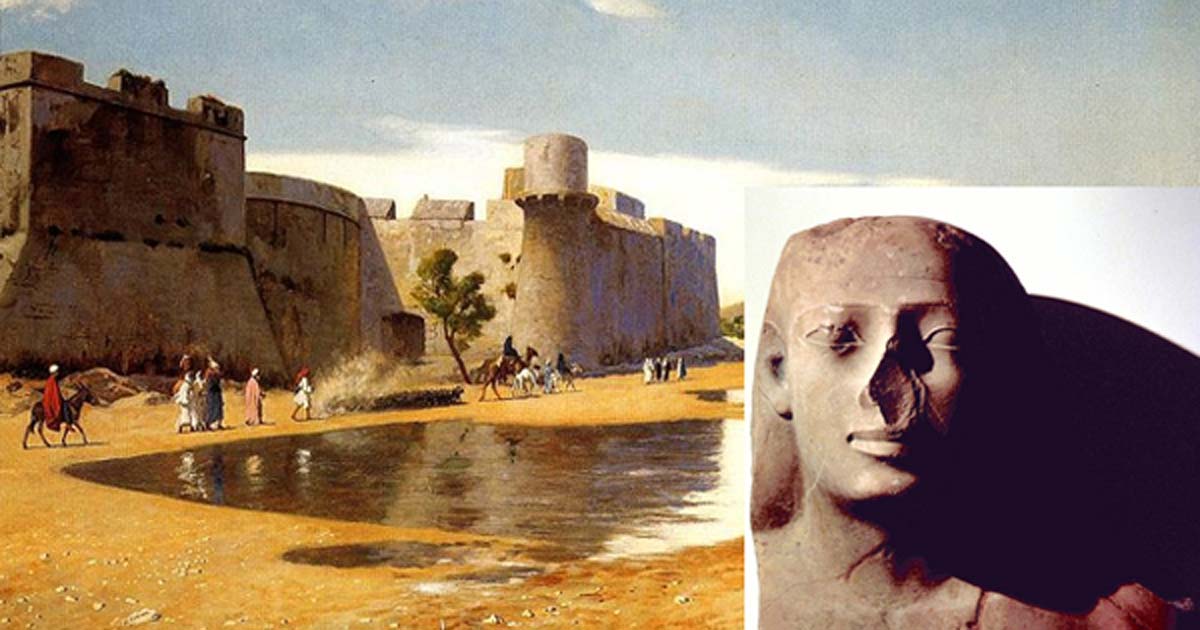Inside Rhinocolura, The City Of Noseless Criminals
Near the city of Gaza, 3,000 years ago, laid a city unlike any other in the world. The Greeks called it Rhinocolura, named for strange faces of the people who lived there – because every person there had no nose.
These men were criminals, and Rhinocolura was their prison. The city was built by one of the kings of ancient Egypt as a punishment for thieves. The men who lived there had all been caught stealing. Their noses were cut off of their faces and they were condemned to live in this city on the edge of the desert.
These men would never again be able to re-enter society. If one managed to escape over the city walls, his severed nose would give him away as a criminal to anyone who saw him. His only choice was to try to eke out some kind of life within the city walls. He might not change his ways, and he might go on tormenting others – but at least, the Egyptians believed, his only victims here would be his fellow criminals.

A depiction of punishment in ancient Egypt. (Public Domain)
Life there was brutal and hard. There was hardly a drop of water in the whole city, with their only source coming from polluted wells buried under the ground. Still, the people in the city survived, catching fish in the sea with reed nets and hunting the few quails that would fly by.
- No Gossiping, Gluttony, Lying, or Eavesdropping! European Metal Masks Would Shame You into Good Behavior
- Why are Noses Missing from so Many Egyptian Statues?
- Analysis of Skeletons Reveals Harsh Punishment in Ancient Egypt
Rhinocolura was a Real Place
Rhinocolura is a city from a different time, when crime and punishment were doled out an eye for an eye. The grotesque city where men with severed nose struggled to survive was, in its time, viewed as an act of benevolence from a lenient ruler.

Bracer (arm guard) of Pharaoh Thutmose IV. The Pharaoh is shown slaying an Asiatic enemy before a god. 18th Dynasty, 1397-1388 BC. Neues Museum, Berlin, Germany. (Osama Shukir Muhammed Amin FRCP(Glasg)/CC BY-SA 4.0)
It’s such a strange place to imagine that some people have written it off as a myth – but Rhinocolura was real. There really was a time in Egypt’s history when criminals’ noses were cut off and they were forced to fend for themselves in a brutal desert city.
The city was likely built around 1300 BC, but little that was written more than 3,000 years ago still exists today. Instead, most of what we know about the city comes from people who lived a thousand years after it was built.
Ancient Greek, Roman and Jewish writers all mention the city, but when these writers lived it was just a normal city with normal people. By then, its strange past was already the stuff of legends. The truth of its history had been muddled, and people believed that it was built around 500 BC by a benevolent Ethiopian king who overthrew the pharaoh. Archaeology, though, suggests otherwise.
In the 1880s, an archaeologist found, for the first time, proof that a city of noseless criminals really existed. The legends that were passed around in 30 BC were true – but it was a far older story than they realized. By then, its story had already lived on for 1,300 years.

Image from the mid 1800s showing the desert forts of Semna & Kumma from the west. (Public Domain)
How To Get Sent To Rhinocolura
That discovery was a stone slab outlining the laws of a pharaoh who ruled between 1321 to 1293 BC. In his tablet, he calls the city Tharu, but this, it’s generally believed, was just the Egyptian name for Rhinocolura.
The tablet warns against stealing from anyone who works to serve the pharaoh. “This is wrong,” the tablet declares, “and the Pharaoh will suppress it by his excellent measures.” These excellent measures perfectly fit the stories of Rhinocolura: “His nose shall be cut off, and he shall be sent to Tharu.”
Horemheb probably built the city, but he doesn’t seem to have been the last one to use it. The tradition of cutting off noses lived on for a long time.

Detail of a statue of Horemheb, at the Kunsthistorisches Museum, Vienna. (CC BY SA 3.0)
Nearly 150 years later, after Ramses III’s wife slit his throat in his sleep, her co-conspirators were sentenced to have their noses removed. “Punishment was executed,” the reports declare, “by noses and ears.”
It’s not completely clear whether these people were sent to Rhinocolura, but they were definitely terrified of the fate that awaited them. One, as soon as he was left alone, took his own life, preferring to die than live branded as a criminal by the severed nose on his face.
Criminals Built One of the Greatest Cities in Egypt
Life in Rhinocolura, was undoubtedly brutal, and it must have felt like a death sentence to the people who were sent there. But despite how hard life there was, something incredible came out of it. About 10 years ago, archaeologists actually found it, and it wasn’t quite what you’d expect. This wasn’t a place where people gave up hope – it was one of the greatest cities in ancient Egypt.

Foundation of a fortress discovered at the site of Tell Habua, old Tjaru, in 2015. (Egyptian Ministry of Antiquities)
Rhinocolura was a massive fortress guarded by a wall 1,640 feet (499.87 meters) long and towers 66 feet (20.12 meters) high. In its time, it was an indomitable city. It was regularly visited by kings, and no army ever managed to conquer it.
These walls were built about 3,000 years ago – around the same time that Horemheb started sending prisoners there. There’s reason to think that’s no coincidence. The Greek writer Herodotus reported an ancient pharaoh, believed to be the founder of Rhinocolura, sentenced criminals to build incredibly high walls. As the walls of Rhinocolura were among the tallest in Egypt, it’s very likely that they were built by condemned men.
- Crime and Punishment: Eternal Damnations as handed down by the Ancient Greek Gods
- Archaeological dig at ancient fortress site in Egypt reveals massive gate and graves of fallen warriors
- From Piso to the Baby Drusilla: The Legal Aspects of Damnation Memoriae - the Punishment of Non-Existence
It gives a little glimmer of hope to the story of the city. The men who lived there definitely struggled through hard lives, but they were given a second chance, and it seems like they took it. The convicted men who filled this city didn’t just squabble, fight and give up – they built a massive city that would be remembered for thousands of years.

Large limestone fragments of the ancient gate at Tjaru Fortress as they were discovered in 2015. (Egypt Antiquities Ministry)
Top Image: ‘An Arab Caravan outside a Fortified Town, Egypt. (Public Domain) Insert: S tatue of a man without a nose. (Public Domain)
By Mark Oliver
Updated on June 25, 2021.
References:
Bossone, Andrew. “Great Fortress’s Remains Found in Egypt”. National Geographic, June 2, 2008. Online. http://news.nationalgeographic.com/news/2008/06/080602-egypt-fort.html
Flavius, Josephus. Anitquities of the Jews. Translated by William Whiston. Online. http://penelope.uchicago.edu/josephus/ant-13.html
Herodotus. Egypt and Scythia. Cassell and Company, 1900. Online. https://books.google.com/books?id=YfhAAAAAYAAJ&printsec=frontcover#v=onepage&q&f=false
Pliny the Eleder. The History of Nature. Translated by Philemon Holland, 1601. Online. http://penelope.uchicago.edu/holland/pliny5.html
Raleigh, Walter. The History of the World. Oxford University Press, 1860. Online. https://books.google.com/books?id=2BoHnNkoN2IC&printsec=frontcover#v=onepage&q&f=false
“Record of the Harm Conspiracy Against Ramses III”. Reshafim, 2002. Online. http://www.reshafim.org.il/ad/egypt/texts/judicial_turin_papyrus.htm
Siculus, Diorodus. The Library of History of Diodorus Siculus. Loeb Classical Library, 1933. Online. http://penelope.uchicago.edu/Thayer/E/Roman/Texts/Diodorus_Siculus/1C*.html#53
Smith, George. The Gentile Nations. Carlton & Phillips, 1854. Online. https://books.google.com/books?id=3WIAAAAAMAAJ&printsec=frontcover#v=onepage&q&f=false
Strabo. Geography. Loeb Classic Library, 1932. Online. http://penelope.uchicago.edu/Thayer/e/roman/texts/strabo/16b*.html
“The Great Edict of Horemheb”. Reshafim. 2002. Online. http://reshafim.org.il/ad/egypt/texts/edict_of_horemheb.htm


















Comments
Good on you Mark! Nice article. Thank you!
As a fellow writer (though unpublished) you did a fine job on this article… and as a archaeology geek, I found it fascinating… aaaannd… also it really grossed me out when I consider what it must have been like to have your nose cut off! Great job though!
Amazing! I had no idea such a city existed!